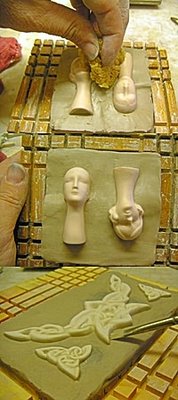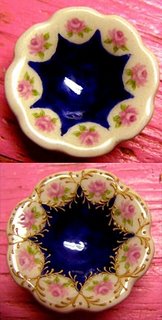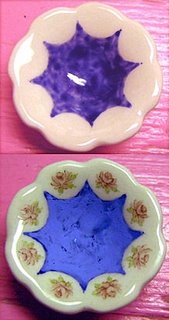
Often I am asked how I make molds. So I have decided to go through it step by step. I will be putting up the steps that I use to make molds. This will not contain all the little tips and tricks but more of an overall view of mold making. I plan on putting together a more complete tutorial including details of the exact tools, special tricks and tips and about twice as many photos. This tutorial will be available on the website for a small fee.
Today I will begin with the basics. In the photo to the right at the top you can see the board that I use to build my molds on. This is simply a piece of 1 X 6 X 6 (actual dimensions are about 3/4 inch thick X 5 1/2 inches X 5 1/2 inches the nominal size for commercial board called 1 X 6) This board has grooves cut across in all four directions 1/2 inch from the edge and 1/2 inch apart in toward the center leaving about a 2 inch square in the middle without any grooves. The grooves were cut on a table saw to a depth of about 1/8 of an inch and are the width of the saw blade. Depending on the type of saw blade you use this might not be sufficient. They need to be wide enough that the acrylic pieces seen to the right of the board will stand up in the grooves. With my saw blade it was a perfect fit and the grooves are about 1/8 inch wide. After all the grooves are cut the board has been given a couple of coats of varathane on both the top and bottom and in the grooves. Be careful not to fill up the grooves just give them a coat of the sealer. This helps prevent the board from warping. This board set up makes it possible to make molds that are as large as 5 inches square or as small as 2 inches square it also makes it easy to handle and turn so you can see the build up for the mold and get it right. It is not the only way to make molds it is just my way. The four acrylic pieces you see to the right of the mold board are the side boards. These particular ones are about 2 inches by about 5 1/2 inches long. If you are making molds of thicker things you will need ones that are wider (more than 2 inches) These were made by cutting up a piece of acrylic that was purchased at a home improvement store. Be sure to get the thin sheets that are about 3/16 inch thick so they will fit into the mold board grooves or take your mold board with you so you can try the fit.
The second photo shows a pair of heads that I will be making molds from it is often useful to draw a line around the pieces you will be making a mold from to help in the clay buildup. This line should be at the widest point on the side of the item to prevent undercuts. When making molds of regular objects such as round beads or vases this is normally 1/2 way but with more complex shapes such as these heads it is a bit more difficult than that and care must be taken to draw the line on the area that the widest. It can be helpful to take a wooden pencil and shave away the wood on one side to reveal the lead along a long section. Then hold the piece you are going to mold on the table in the orientation that you plan to place it in the mold. Run the pencil around the piece holding the exposed lead against the side of the piece. This should put a line at the widest point. Personally I prefer to draw the line by looking at the piece carefully but this method works for some people. In the photo you can see the line that I have drawn.
The next step is to put a bed of clay on the mold board. I use what is generally referred to as school clay. It is an earthenware clay that is very smooth and has no grog or sand in it. I have been using the same clay for over 10 years and it originally cost me about $7 for 25 lbs so this is a pretty economical way of making molds. I keep my mold clay in a small tupperware box and use it just for making molds. The bed of clay should be about 1/4 inch thick and should be large enough to extend at least 1/4 to 1/2 inch out from the model in all directions. In this mold for heads the model is hollow so it must be filled with the clay. Fill it and flatten off the clay even with the bottom of the neck in this case. After you have the bed of clay on the mold board and a hollow model filled, position the piece(s) that you will be making a mold of on the clay. Pay careful attention that the parting lines that you drew in the previous step are horizontal and not slanted. Also that the pour hole end is vertical and not slanted. You can see this in the third (bottom) photo. Also notice that there is space under the neck of the closest head in the photo, this needs to be filled in with clay.








